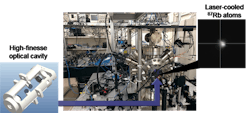UEC researchers control one photon with another for quantum information processing
Photonics plays an important role in quantum communications and information processing, where quantum mechanics allows for absolutely secure cryptographic-key distribution as well as, potentially, computation much faster than conventional computers. In order to take full advantage of quantum information carried by photons, it is important to make them directly interact with each other for information processing.
However, photons generally do not interact with one another. So it is necessary to mediate such interactions with matter to realize effective photon-photon interaction, but light-matter interaction is usually extremely weak in normal media.
Haruka Tanji-Suzuki and colleagues at the Institute for Laser Science, the University of Electro-Communications (UEC; Tokyo, Japan) are currently working to develop all-optical quantum devices that are sensitive to a single-photon input, such as a single-photon switch in which an incoming photon switches the state of another photon.
To realize the strong light-matter interaction that is necessary for such devices, Tanji-Suzuki uses a laser-cooled ensemble of rubidium (87Rb) atoms at a temperature of about 10 uK trapped within a high-finesse optical resonator with a finesse of about 50,000 in an ultrahigh-vacuum chamber. Notably, in order to switch a photon with a photon in such a system, the researchers use an effect known as 'vacuum-induced transparency' observed by Tanji-Suzuki and her group, in which an electromagnetic field as weak as a vacuum field (light with no photons) is shown to alter the optical properties of atoms.
"The realization of such all-optical single-photon devices will be a large step towards deterministic multi-mode entanglement generation as well as high-fidelity photonic quantum gates that are crucial for all-optical quantum information processing," says Tanji-Suzuki.
About the Author
John Wallace
Senior Technical Editor (1998-2022)
John Wallace was with Laser Focus World for nearly 25 years, retiring in late June 2022. He obtained a bachelor's degree in mechanical engineering and physics at Rutgers University and a master's in optical engineering at the University of Rochester. Before becoming an editor, John worked as an engineer at RCA, Exxon, Eastman Kodak, and GCA Corporation.

